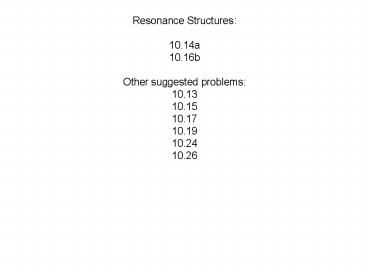Resonance Structures:
1 / 13
Title: Resonance Structures:
1
Resonance Structures 10.14a 10.16b Other
suggested problems 10.13 10.15 10.17 10.19 10.24
10.26
2
Formal charge valence e- - ( unshared
valance e- ½ shared valence e-)
Criteria for choosing the more important
resonance structure (1) Smaller formal
charges ( or -) are preferable to larger
ones. Resonance form I is out. (2) The
same nonzero formal charges on adjacent atoms are
not preferred. Not applicable to this
example. (3) A more negative formal charge
should reside on a more electronegative atom. O
is more EN than N, so Resonance form III is the
winner.
3
Section 10.2 Valence-shell electron-pair
repulsion (VSEPR) theory Molecular shape is
important in many, many scientific disciplines.
Medicine Receptors
Nanotechnology Membrane Transport
4
Section 10.2 Valence-shell electron-pair
repulsion (VSEPR) theory Molecular shape is
important in many, many scientific disciplines.
Ecology Talking trees
Jack Schultz, Chemical Ecologist
5
Section 10.2 Valence-shell electron-pair
repulsion (VSEPR) theory
Lewis Dot Structures, 2D (Blueprint)
VSEPR, 3D (House)
6
Section 10.2 Valence-shell electron-pair
repulsion (VSEPR) theory Each group of valence
electrons around a central atom is located as far
away as possible from the others in order to
minimize repulsions.
e- group can be a single bond, double bond,
triple bond, lone pair, lone e-
7
(No Transcript)
8
Section 10.3 Molecular Shape and Molecular
Polarity In molecules with more than 2 atoms
Shape and bond polarity determine molecular
polarity.
Molecules with only 2 atoms.
Relative electronegativities of the two atoms
determine polarity.
9
Section 10.3 Molecular Shape and Molecular
Polarity In molecules with more than 2 atoms
Dipole moments
Dipole moments a measure of molecular
polarity magnitude of partial charges on ends of
a molecule (in coulombs) x distance
between them
Behavior of Molecules With and Without Dipole
Moments Electric field Polar molecules (which
have a dipole moment) orient with partial
charges towards oppositely charged electric
plates. Molecules with out a dipole moment will
not orient themselves in any particular
direction. Molecules with no dipole moment can
be polar.
10
Section 10.3 Molecular Shape and Molecular
Polarity Dipole moments When molecular shape
influences polarity
Large ?EN between C (EN 2.5) and O (EN 3.5) ?
C O bonds are polar CO2 molecule is linear ?
Two identical bond polarities are counterbalanced
(in other words, they cancel each other out) As
a result, CO2 has no net dipole moment.
11
Section 10.3 Molecular Shape and Molecular
Polarity Dipole moments When molecular shape
influences polarity
H2O (like CO2) also has two identical molecules
bonded to the central atom.
However, H2O (unlike CO2) has a dipole
moment. Bond polarities are not canceled out
because of the shape of the water
molecule V-shaped rather than linear. The O
end of the molecule is more negative than the H
ends
12
Section 10.3 Molecular Shape and Molecular
Polarity When different molecules have the same
shape, the nature of the atoms Surrounding the
central atom can have a major effect on polarity.
CCl4 does not have a dipole CHCl3 has a
dipole
13
(No Transcript)































